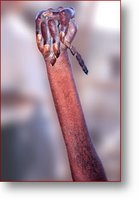




 The Irony of the Negro Policeman (the print I wanted but they didn't have)
The Irony of the Negro Policeman (the print I wanted but they didn't have)The sheer size of the paintings is awesome, it's hard to know where to look first, the colors pull you in so many directions. I found The Irony the most striking of all the images and it was one that I was unfamiliar with. Some genius once said that if you look at things a different way; out of focus, you can concentrate on the bigger picture without being distracted by the details. I tried it with several of the Basquiats by taking off my glasses, The Irony had the most impact. It's hard to tell in this image, but if you've seen the painting in person you'll appreciate the colors, the way the blues melt together, it's hard to stop looking at it. I wanted to stand there all day but I had a date with some chili.
What I enjoy most about Basquiat is his use of urban subjects. He may like to relay his African and Jamaican heritage and the ties that lead back to slavery, his love of jazz, boxing and anatomy and his morbid memories of childhood, but he always seems drawn to the harsh realities of life in the big city: Poverty, money, low income housing, advertising, flashes of real life come through amidst the history and culture he uses to tie his life together.
It was all it could have been and then some.
Is it a laundry shoot? Is it part of Wallace and Gromit's morning routine?
No, it is in fact an emergency exit, used back in the day, before the rust set in, ouch!
In other words - Bullshit. I'm not very good at it, it involves long, waffling sentences that include grand, meaningful words. Someone that is adept at BS is the fabulous, and I mean FABULOUS DARLING, Mr. Charles Birnbaum, FASLA

founder of the Cultural Landscape Foundation and overall cutie-pie. He can rattle on for hours about the importance of historical landscape preservation as proven at our office on Wednesday. I say rattle, but really it's far from rattling, it's almost hypnotic and dreamy and extremely informative. Miss Margaret (who, of course, was immediately taken with CB) and I came to the conclusion that he actually makes up some of his big words. Maybe I should take a well preserved leaf from his book, Design with Culture: the one he personally signed for me...





Cows, though revered as sacred, roam freely and are allowed to die slow and painful deaths by grazing on the thousands of plastic bags that line the streets. The bags collect in their stomachs, strangulating the innards. 
Swimming in the Ganges is thought to cleanse you of sin. What they don't tell you is that babies are not cremated in India, but their bodies are left to float down the river, insuring that their souls will pass to heaven.
MacDonald talks about the peace, love and joy shared by Hindus, but how about this practice...When a greedy family wants more dowry money from the bride's parents, they set her alight and leave her in the streets, if she dies from her wounds the husband is set free to move on to a new bride, if she survives the family is "allowed" to abandon her as damaged, or worthless goods.
To this day, girls are not counted as children. Even farm stock is given pride of place above a daughter.
Hindu Sadhus, or holy men, perform atrocities to their bodies to show that pain means nothing; their minds and bodies are given over to worshiping God. One such Sadhu has held his hand in the air for three decades, his limb becoming withered and useless. I think he proved his point.
Parsi, an ancient religion, almost extinct in its pure form, is turning to modern science to aid the passing of its departing spirits. Parsi are known for their love and respect of nature, they will do nothing to pollute or harm the earth or its creatures, even down to their burial rituals: The Parsi leave their dead out in the open for the vultures to feed on; believing that the flesh is returning to nature when being eaten by the bird. Problems recently began when the particular species of vulture who habitat the area of Bombay which is home to the Parsi, began to die out. The rotting corpses lying out in the open began to cause major problems, so solar panels were installed to "speed things up".
While Hindus make up over 80% of the population, India is home to many other religious practitioners including Muslims, Jews, Christians, Catholics, Buddhists, Sufis, Sikhs, Parsis and Jains.










